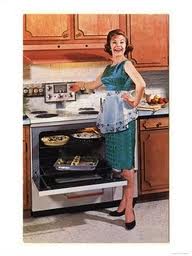Women today have overcome the immense repression from previous generations. They have gained the right to vote, have fought their way into political positions, and hold full-time jobs. Women in the workforce hold jobs right next to men, doing the same work, and performing at the same rate. Many women choose to be stay at home moms when their husband can financially support the family without a second income. This however, is a choice, rather than an expected role as it was in the past. Women today pride themselves as being completely equal with men, and have proved themselves in many aspects to be just that.
Changing of Women's Societal Roles
Wednesday, May 2, 2012
Women of the 50s
Although the
number of women at work did continue to rise after the
war, female workers and career-women were viewed with suspicion by
many. The traditional idea that a woman’s role
was a homemaker raising her family was very
influential in1950s USA. The average age at which women were married was 20 – the youngest for
60 years. Newspaper and magazine articles encouraged women to return to the
home. Popular TV shows such as 'I Love Lucy' and 'Father Knows Best'
carried this message into homes. It claimed that most of society’s problems –
alcoholism, teenage hooliganism and even war – were because of women following
careers instead of being housewives and mothers.
Women of the 20s
Despite increasing opportunities in employment and education,
and the expanding concept of a “woman’s place,” marriage remained the goal of
most young women. Magazine articles and movies encouraged women to believe that
their economic security and social status depended on a successful marriage.
The majority worked only until they married. The flapper—with her short skirts, short hair, noticeable
makeup, and fun-loving attitude—represented a new freedom for women. The old restrictions
on dress and behavior were being overthrown. Highly publicized flappers
shortened their skirts, drank illegal alcohol, smoked, and otherwise defied
society’s expectations of proper conduct for young women.
Women of the Dark Ages 500-1000 A.D.
The women of the Middle Ages were totally dominated
by the male members of their family. The women were expected to instantly obey
not only their father, but also their brothers and any other male members of
the family. Any unruly girls were beaten into submission and disobedience was
seen as a crime against religion. Woman's inferior status was governed completely
because of one fatal failure: her sex. The Church blamed Eve for the Fall of
Man and thus the woman was in fact an instrument of the Devil, to be feared
more than the poison of snakes. Women were objects who were bought and sold.
Girls were punished for reducing their value by losing their virginity. Woman
was both revered and abhorred; she was seen as a necessary evil but, because of
the nature of medieval life, women were of as much value to the smooth
functioning of daily life as men were.
Women of Ancient Greece 3300-31 B.C.
Athenian philosophers, except Plato, held that women had a very poor mind but a strong emotional realm. They could harm themselves and other people, therefore they should have been protected from themselves and, when possible, incapacitated. That’s why each woman had her own guardian – usually father, brother, husband or other relative of her. A woman could own a property, such as clothes, jewellery, slaves, however, she wasn’t able to buy anything, to own a land or to contract. A guardian controlled all aspects of her life. Athenian citizenship enabled her to marry another citizen, to participate in religious ceremonies, but she still had no voting right or financial independence. Each wife’s duty was to born legitimate children and to manage the chores in an economical way. She was expected to remain inside her home.
Tuesday, April 17, 2012
Women of the Shang Dynasty 1800-1200 B.C.
The role of the woman was to be gentle, calm, respectful, and to obey her husband. Women were lower than men and were subjected to women’s work (tending to the children and needs of the husband). Men also married multiple times and women were used as concubines.
Women of Ancient Egypt 3000-2000 B.C.
Egyptian women achieved parity with Egyptian men. They enjoyed the same legal and economic rights. The disparities between people's legal rights were based on differences in social class and not on gender. Egyptian women's rights extended to all legally defined areas of Egyptian civilization. Women could manage, own, and sell private property, which included slaves, land, portable goods, servants, livestock, and money. Women could resolve legal settlements. Women could appear as a contracting partner in a marriage contract or a divorce contract; they could execute testaments; they could free slaves; women could make adoptions. Women were entitled to sue at law. On the death of a husband the woman inherited two-thirds of their community property, but the other one-third was divided among their children, followed up by the brothers and sisters of the deceased. A girl became universally acknowledged as a wife after she physically left the protection of her father's house and entered her new home. The new husband in no way became the new wife's legal guardian. The wife kept her independence, and still kept control her own assets. Although the husband usually controlled any joint property obtained during the marriage it was acknowledged that a share of this belonged to the wife; if and when the marriage ended, she could collect he share. Pregnancy was very important to ancient Egyptian women. A fertile woman was a successful woman. By becoming pregnant, women gained the respect of society, approval from their husbands, and the admiration of their less-fortunate sisters and sterile friends.
Subscribe to:
Comments (Atom)






